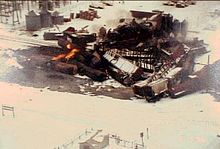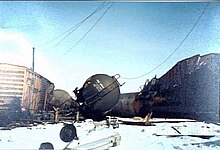Weyauwega railway accident
The Weyauwega rail accident was a major accident after the derailment of a freight train on the morning of March 4, 1996 in Weyauwega , Wisconsin , which had loaded dangerous goods. The fire caused by this could only be extinguished after 16 days.
Starting position
A Wisconsin Central freight train was traveling in wintry weather at -12 ° C with 81 freight cars from Stevens Point , Wisconsin, to Neenah , Wisconsin. 14 of the wagons were tank wagons filled with propane gas . At almost 80 km / h, the train approached Weyauwega on a downward gradient.
the accident
At 5:49 a.m., the train ran over a defective switch in the local area of Weyauwega , in which a rail had broken and a lock had been missing for over a year. After the locomotive and 16 cars had passed over it, a section of track broke and the following 37 cars derailed, tore over a high-voltage line and blocked a level crossing . This happened next to a flour mill .
Seven cars loaded with liquefied petroleum gas and another seven with propane gas derailed and ignited immediately. Two cars full of sodium hydroxide also leaked.
A train attendant released the clutch after the ninth car, so that the locomotive and these cars could move out of the danger area. He then informed the local authorities, including which dangerous goods the train was transporting. Later the Zugspitze drove back again and pulled all non-derailed wagons out of the danger area.
consequences
When the local fire department arrived after just five minutes , the cars exploded in fireballs up to 100 meters high, which were seen more than 20 km in a radius. The town's main water supply and a natural gas pipeline were also damaged. The fire immediately spread to the flour mill and its storeroom. Since the level crossing was blocked, it was difficult for the fire department to reach the building. The damaged high-voltage line caused arcing and ignited further fires.
It was immediately clear to the local fire department that this fire was too big to get under control on their own. 10 other fire brigades from the area were called in. About an hour after the accident , the railway company informed the fire brigade that the derailed but otherwise undamaged tank wagons could only withstand a fire for about 90 minutes. The fire brigade withdrew immediately and ultimately about 2.5 km from the burning train because of the danger of explosion. Immediately after the fire brigade had withdrawn, one of the tank wagons filled with liquid gas exploded.
At the same time, a wide range of 2300 people were evacuated, including the entire village of Weyauwega with 1700 residents. The evacuation should then last 16 days. The National Guard of the United States was after 4 days with armored personnel carriers and bulletproof vests used to evacuate abandoned pets, dogs, cats, birds, snakes, a goat and a Iguana . The rail company eventually even deployed professional firefighters from Texas . Weyauwega was only declared safe again on March 20 and the residents were able to return.
The railway company put the damage at $ 28 million.
The accident was investigated by the National Transportation Safety Board and the results published in a report.
See also
swell
- John C. Cabaniss: Railroad Negligence - Derailment - Settlement ( Memento of March 14, 2007 in the Internet Archive ).
- United States National Transportation Safety Board (ed.): Derailment / Hazardous Material Release; Wisconsin Central Ltd; Weyauwega, Wisconsin . 1997.
- Rudi Williams: Ace Guardsmen: Pet Rescuers . In: American Forces Press Service.
- Wisconsin Central Transportation Corporation: 1996 Annual Report . 1997.
Individual evidence
- ↑ Cabaniss
- ↑ United States National Transportation Safety Board.
- ↑ Williams.
- ^ Wisconsin Central Transportation Corporation: 1996 Annual Report .
- ↑ United States National Transportation Safety Board.
Coordinates: 44 ° 19 ′ 46.3 " N , 88 ° 56 ′ 4.5" W.

